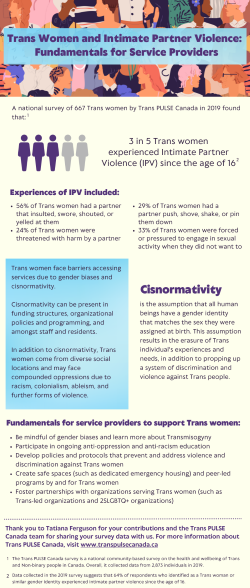Our Work
.
Trans Women and Intimate Partner Violence Fundamentals for Service Providers
 This infographic shares data from a national Trans PULSE Canada survey regarding Trans women's experiences of intimate partner violence.
This infographic shares data from a national Trans PULSE Canada survey regarding Trans women's experiences of intimate partner violence.
It identifies barriers Trans women face in accessing services and offers some fundamentals for service providers to support Trans women.
Click here for an image of the infographic (PNG)
Click here for a PDF of the infographic
Trans Women and Intimate Partner Violence: Fundamentals for Service Providers
A national survey of 667 Trans women by Trans PULSE Canada in 2019 found that:[1]
3 in 5 Trans women experienced Intimate Partner Violence (IPV) since the age of 16[2]
Experiences of IPV included:
- 56% of Trans women had a partner that insulted, swore, shouted, or yelled at them
- 24% of Trans women were threatened with harm by a partner
- 29% of Trans women had a partner push, shove, shake, or pin them down
- 33% of Trans women were forced or pressured to engage in sexual activity when they did not want to
|
Cisnormativity is the assumption that all human beings have a gender identity that matches the sex they were assigned at birth. This assumption results in the erasure of Trans individual’s experiences and needs, in addition to propping up a system of discrimination and violence against Trans people. |
Trans women face barriers accessing services due to gender biases and cisnormativity.
Cisnormativity can be present in funding structures, organizational policies and programming, and amongst staff and residents.
In addition to cisnormativity, Trans women come from diverse social locations and may face compounded oppressions due to racism, colonialism, ableism, and further forms of violence.
Fundamentals for service providers to support Trans women:
- Be mindful of gender biases and learn more about Transmisogyny
- Participate in ongoing anti-oppression and anti-racism education
- Develop policies and protocols that prevent and address violence and discrimination against Trans women
- Create safe spaces (such as dedicated emergency housing) and peer-led programs by and for Trans women
- Foster partnerships with organizations serving Trans women (such as Trans-led organizations and 2SLGBTQ+ organizations)
Thank you to Tatiana Ferguson for your contributions and the Trans PULSE Canada team for sharing your survey data with us. For more information about Trans PULSE Canada, visit www.transpulsecanada.ca.
[1] The Trans PULSE Canada survey is a national community-based survey on the health and wellbeing of Trans and Non-binary people in Canada. Overall, it collected data from 2,873 individuals in 2019.
[2] Data collected in the 2019 survey suggests that 64% of respondents who identified as a Trans woman or similar gender identity experienced intimate partner violence since the age of 16.
All our resources are open-access and can be shared (e.g., linked, downloaded and sent) or cited with credit. If you would like to adapt and/or edit, translate, or embed/upload our content on your website/training materials (e.g., Webinar video), please email us at gbvln@uwo.ca so that we can work together to do so.






